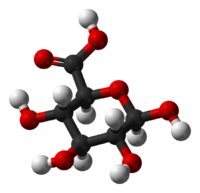葡萄糖醛酸
外觀
| D-葡糖醛酸 | |
|---|---|

| |

| |
| 英文名 | Glucuronic acid |
| 別名 | β-D-葡萄糖醛酸;葡萄糖醛酸 |
| 識別 | |
| CAS號 | 6556-12-3 (D-葡糖醛酸) |
| PubChem | 610 |
| ChemSpider | 392615 |
| SMILES |
|
| InChI |
|
| InChIKey | AEMOLEFTQBMNLQ-WAXACMCWBB |
| ChEBI | 28860 |
| DrugBank | DB03156 |
| KEGG | C00191 |
| MeSH | Glucuronic+acid |
| 性質 | |
| 化學式 | C6H10O7 |
| 摩爾質量 | 194.14 g·mol−1 |
| 外觀 | 結晶 |
| 熔點 | 165 °C |
| 危險性 | |
| 歐盟危險性符號 | |
| 警示術語 | R:R36/37/38 |
| 安全術語 | S:S26, S37/39 |
| 若非註明,所有數據均出自標準狀態(25 ℃,100 kPa)下。 | |
葡糖醛酸(Glucuronic acid),又稱葡萄糖醛酸,是葡萄糖的 C-6 羥基被氧化為羧基形成的糖醛酸。D-葡糖醛酸一般不以游離的形式存在,因為該形式不穩定,而是以更穩定的呋喃環的 3,6-內酯形式存在。D-葡萄吡喃糖醛酸存在於糖胺聚糖鏈連接處的寡糖中,[1] 也存在於肝素和軟骨素中。[2]
生物轉化
[編輯]肝細胞微粒體中含有非常活躍的葡糖醛酸基轉移酶,它以尿苷二磷酸葡糖醛酸(UDP-葡糖醛酸)為供體,催化葡糖醛酸基轉移到多種含有極性基團的化合物(包括藥物、毒藥和激素)上,如酚、醇、胺和羧酸等,生成β-葡糖醛酸苷。這個過程增大了化合物在水中的溶解度,是肝臟生物轉化作用中最普遍的一種結合反應。以存在於人類、大鼠和小鼠中的 UGT1A4 或 UGT1A9 對4-氨基聯苯的 N-葡糖醛酸基化為例:[3]
構象
[編輯]與 C-5 差向異構體艾杜糖醛酸不同的是,葡糖醛酸分子主要採取 4C1 構象(詳見糖類構象)。[4] 下圖所示的是通過從頭計算得到的 β-D-葡糖醛酸甲基苷的結構:
參見
[編輯]參考資料
[編輯]- ^ Langqiu Chen, Fanzuo Kong. A practical synthesis of β-D-GlcA-(1→3)-β-D-Gal-(1→3)-β-D-Gal-(1→4)-D-Xyl, a part of the common linkage region of a glycosaminoglycan. Carbohydr. Res. 2002, 337 (15): 1373–1380. doi:10.1016/S0008-6215(02)00169-6.
- ^ Renato V. Iozzo. Matrix Proteoglycans: From Molecular Design to Cellular Function. Ann. Rev. Biochem. 1998, 67: 609–652. doi:10.1146/annurev.biochem.67.1.609.
- ^ Al-Zoughool M., Talaska, G. 4-Aminobiphenyl N-glucuronidation by liver microsomes: optimization of the reaction conditions and characterization of the UDP-glucoronosyltransferase isoforms. J. Appl. Toxicology. 2006, 26: 524–532. doi:10.1002/jat.1172.
- ^ Ferro, D. R. Provasoli, A. Conformer populations of L-iduronic acid residues in glycosaminoglycan sequences. Carbohydr. Res. 1990, 195: 157–167. PMID 2331699. doi:10.1016/0008-6215(90)84164-P.




